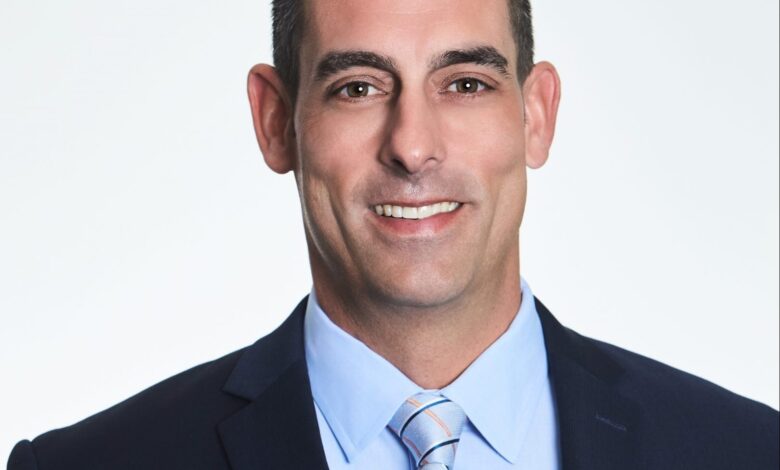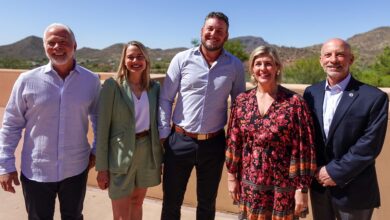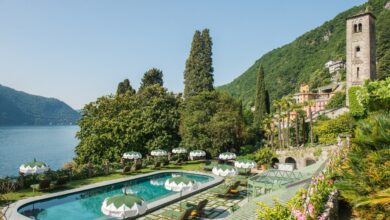
Engaging with Executives: Kevin Schramm, IHG Hotels & Resorts’ SVP of Development Mainstream Brands
By David Berman | May 18, 2023
Our Engaging with Executives series consists of one-on-one Q&As with executives around the hospitality industry, breaking down recent trends and news in their companies and the industry as a whole.
Today’s interview is with Kevin Schramm, Senior Vice President of Development Mainstream Brands for US and Canada at IHG Hotels & Resorts. Schramm’s career in hospitality dates back to college, as he started in the restaurant industry before transitioning to hotels in 2000. He previously was the Senior Director of Development for Cendant Corporation and Vice President of Development for Hyatt Hotels Corporation before joining IHG in 2013. He has been in his current role since 2019.
In this Q&A from April, Schramm discusses IHG’s brand development over the last year and projected what’s next for brand growth at the company.
Hotel Interactive: I’d like to start off with a question about the growth that IHG saw in 2022. What goals/milestones were hit there?
Kevin Schramm: We’re a very growth oriented company on all levels. I’ll touch upon maybe the (most) unexpected growth metric, which is the growth of our loyalty program, which is instrumental in us attracting investment from franchisees because they really rely on the strength of the IHG One Rewards program to bring guests to their hotels. We took on a very significant improvement of the program, as well as put a tremendous amount of investment capital toward marketing the program. The fruits of those labor were 12 million new IHG One Rewards members added and welcomed in, in 2022.
In terms of actual hotel growth, we had 269 new hotels open, 125 of those in the Americas. So clearly the Americas region for IHG is the dominant producer. Those were across all 18 of our brands. We signed globally 467 hotels, bringing our pipeline to over 1800 in total; again, over half of those in the Americas region. We attribute that growth to the strength of the performance in the industry. Consumers and travelers are showing a willingness and perhaps even a stronger preference for travel than we’ve ever seen. That’s paying dividends at the hotel levels where occupancies rise, ADRs are increasing rapidly and our owners are really seeing the returns on their invested capital.
Based on the pipeline in 2022, what we’ve targeted in 2023 and expect in the future, it’s really built on hotel owners’ desire to grow, to build new hotels but also we’re seeing a little bit of a pivot. I think it’s largely a short-term pivot based on economic headwinds, but I do believe there’s some sustainability to the emphasis on conversions. We’re seeing conversions being a larger percentage of our growth mix. About 25% of our signings were via conversions last year. I’d anticipate that number to be slightly up this year, but I’m not so sure that it returns to previous levels. I think it remains a little elevated.
I’ll give my personal opinion on the subject. There’s an age old saying that our business isn’t over-built, it’s under demolished. While there is a lot of truth to the need to really rid archaic, antiquated hotel stock from from the overall supply, I think there’s a lot of hotels that are well-positioned in strong markets that have upside in rebranding and affiliating, obviously with IHG brands and taking advantage of of the strength of our company, feeding back to the delivery side and the membership base that we have had and have grown.
HI: I was curious about that 269 hotel number and how that compares to 2021 and also pre-pandemic times. How did the pandemic impact development and is that number now back up to a standard IHG year pre pandemic?
KS: Yeah, I mean, the pandemic had a pretty profound impact on development in a number of ways. First and foremost, it’s a gut punch to owners and operators. Some felt it more than others, depending upon the leverage that they put on their assets, the market positioning of their hotels. For example, our extended stay owners, specifically, our Candlewood Suites owners, have told me consistently, thank god they had the Candlewood Suites in their portfolio because it really helped buoy the rest of the losses. Certainly the government helped out with some subsidies there, but the wounds were deep in some cases. Those operating losses required a redeployment of capital that maybe was earmarked for development or growth opportunities, so it slowed down from an economic standpoint.
Supply chain disruption really, really created havoc on new development. Up until this point in time today, you can be waiting almost a year to get an electrical panel, clearly an essential item if you’re trying to open a new hotel. So that delay in delivery of necessary goods creates an overall slowdown and a lag in hotel openings. Now we had a very strong pipeline going into the pandemic. We saw the folks that persevered through it and continued to develop amidst turmoil and dark skies are being rewarded heavily because they’re opening up at a time where overall openings in the industry are down. Our avid brand particularly benefited during this time, we nearly doubled the size of our avid hotels portfolio since the onset of the pandemic in March of 2020. So we continue to see that growth and development through the current challenges.
HI: There have been seven brands added to IHG in the last five years: Iberostar Beachfront Resorts, avid hotels, Atwell Suites, voco hotels, Vignette collection, Regent Hotels & Resorts, and Six Senses. Talk a little bit about those brands and their development in the last half-decade.
KS: First of all, I’ll say if you look at our most direct competitors, Hilton and Marriott, they have more brands than we have even post (those) seven. So, what we’ve seen is kind of an expansion of brand companies’ portfolios, but believe it or not, Hyatt and Best Western have more brands than IHG, and Wyndham’s off the charts. So all brand companies have kind of grown. We have a lot of room to grow, because you add seven, brings you to 18, so you’re starting with 11. There’s a lot of lanes out there in the marketplace that we weren’t fully covering.
I’ll start low and go high. This isn’t in sequence of how we added the brands, but I’ll give you a little bit of the philosophy behind it. Our strongest brand, as you’ve probably figured out, is Holiday Inn Express. So it’s our largest brand that makes up the most significant portion of our portfolio, it makes up the most significant percentage of our signings, on down the line. So we wanted to really leverage that strength, and the first leverage point off of that was avid hotels, where we said, okay, if we go to a price point below Holiday Inn Express at a cost point below, we’ll mimic the return on investment profile that our owners have enjoyed for decades. So that was the philosophy there. We didn’t have a limited service hotel priced below Holiday Inn Express.
Similar philosophical approach to Atwell Suites, where (it’s) a price point above, a cost point above. The point of differentiation with Atwell Suites is that it’s an all-suite hotel. So we looked at what are the suites out of our Holiday Inn Express estate drive in terms of revenue compared to the standard guestrooms? So there was an opportunity there for an all-suite product with a little bit of a lifestyle flair. If you’ve seen the photography on it, you see a boutique-y looking feeling product at an unexpected price point in the marketplace. An all-suite format was popular when we launched it. It’s even more popular today, as folks are traveling. Those vacation times are extending as the office hours or in-office hours are on the decline.
When we get into our upscale portfolio, this is where I’m knowledgeable enough to be dangerous, so please don’t hurt me on this one. We look at voco and Vignette as predominantly conversion opportunities. Again, there’s a lot of great hotels in great spots that could really benefit from the support of IHG Hotels & Resorts on many levels. So in an upscale lifestyle market positioning, we have voco, that slots in right underneath our Indigo brand which has been (a) lifestyle product for quite some time. As we kind of build out this ladder in the lifestyle space, you go above Indigo to Kimpton and then you go above Kimpton to Vignette. Vignette is more of a collection, voco has some branding elements weaving through it, so there’s a little bit of a common DNA in each hotel, whereas Vignette being a very upscale lifestyle product, is very, very unique to each location. Regent is probably more of an international play for us than a domestic play, given its strength in Asian markets.
As you look at these strategic moves, you see we’re kind of starting to round out our product offering, where we’re making IHG more approachable for more guests overall, with avid getting into the masses and allowing those consumers to be part of what we have to offer and grow into our other brands along the way, filling holes in the lifestyle space, and then topping it off with Six Senses, which is uber-luxury, high-experiential. In most locations, you’re dealing with a fully on-site experience, farm to table cuisine that’s locally sourced in many instances. That gives us just that next level of luxury. We’ve always been a dominant player in the luxury segment with InterContinental Hotels being the largest luxury brand in the world. You plug in Regent, you add Six Senses, and now you start to have this really well-balanced, well-rounded, well-defined portfolio of brands.
HI: As you mentioned, the largest single brand in IHG’s portfolio is Holiday Inn Express. What’s the importance of that brand to IHG, and what’s next for it?
KS:It’s obviously very important to us. You have 3000 of them, so there’s some constraints on opportunities to continue to grow. However, as demand increases, as sprawl occurs, as new markets emerge, as new demand generators come into play, there’s always locations for Holiday Inn Express to continue its growth trajectory. Holiday Inn Express, I’d call it a brand with extreme rate elasticity. It’s a product that can fit in a tertiary market, on a roadside, and hit a return for an owner and then it can go into an urban or a resort location and really push the high end of the ADR spectrum there. It’s great value proposition for owners, great value proposition for guests. So that will continue, the demand to grow will continue to be there.
There’s been evolutions over time, both prototypical evolutions as well as a kind of macro market positioning evolution. When Holiday Inn Express was originally launched, it was more of a motel. Now it’s a hotel, and there’s a big difference between those two products. As you move up, as you ascend from here to there, you have different iterations of the facility. Some of those facilities just no longer align with what the customer’s expectation of an upper midscale lodging facility is today, and that’s where Holiday Inn Express is positioned, that’s where it will, the likelihood, continue to remain positioned. We’re not looking to make it an upscale product, but we want to really maintain that strength in that upper-midscale, limited-service space. And so in order to do that, some of the hotels that are older generation hotels are going to end up being replaced as their licenses come up.
We see a fairly significant amount of that activity coming from the existing licensee, where they love the market, they love what they’ve invested in the brand. They love the partnership and everything about it. The facility needs to be repositioned, but a new one makes a lot of sense for them. Self replacement really is a significant portion of what you’ve seen in our growth in 2022 and what we’ll see in the future.
HI: What’s next for IHG? What are some goals for the company for the rest of the year and beyond?
KS: Having growth, growth, growth; that’s every publicly traded branding company’s fight song. So we sing that as well. We want to continue to emphasize growth, but emphasize growth across all of our brands, particularly avid hotels and Atwell Suites. Those are our two next real brands of scale. Avid, we got off to a great start. Pandemic hits, the marketplace changes, but we’ve got 60 of them open. We’ve got 140 in the pipeline. We’ve seen very strong performance out of those hotels and very happy owners operating and trading out of them. They’re selling at significant profits and the buyers are coming in, and even though their basis is elevated, are enjoying the operational income. So really emphasizing continued growth and distribution of that brand where our runway is wide open.
Atwell Suites, we’re going to open our third one later this year. Context is very significant when we talk about Atwell Suites’ growth development and scale at this point. We went to market in September of 2019, so obviously we had about five months before, boom, world falls apart. So not too dissimilar to when Home2 (Suites), which is in the competitive set for Atwell Suites, was launched by Hilton back in the Great Recession. So Hilton’s done just fine. We feel great about the position of that brand and continue to emphasize the growth of that product, as well as all of our other brands. Those are the two that we maybe really highlight more because the opportunity is so significant based on relative distribution compared to the product that it mimics, which is Holiday Inn Express.
This interview has been lightly edited for length and clarity.





Get involved!
Comments